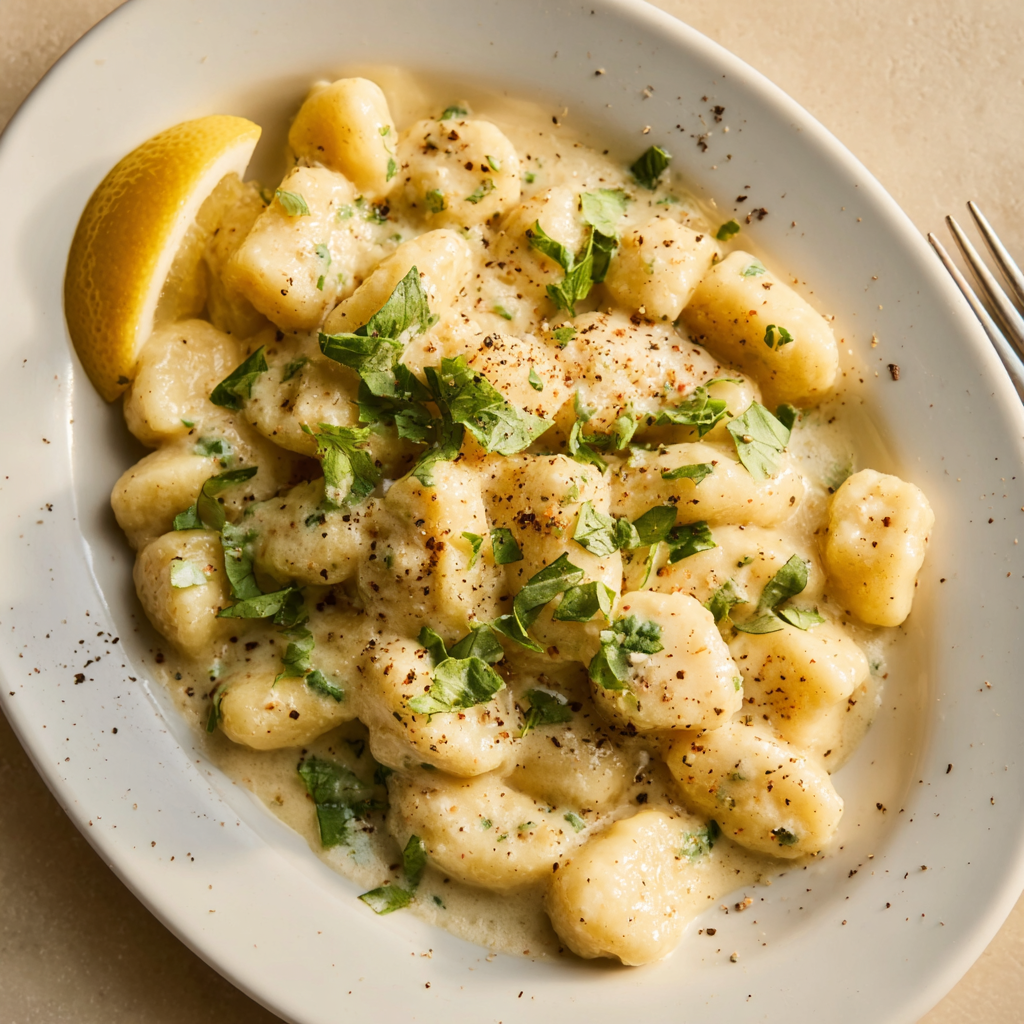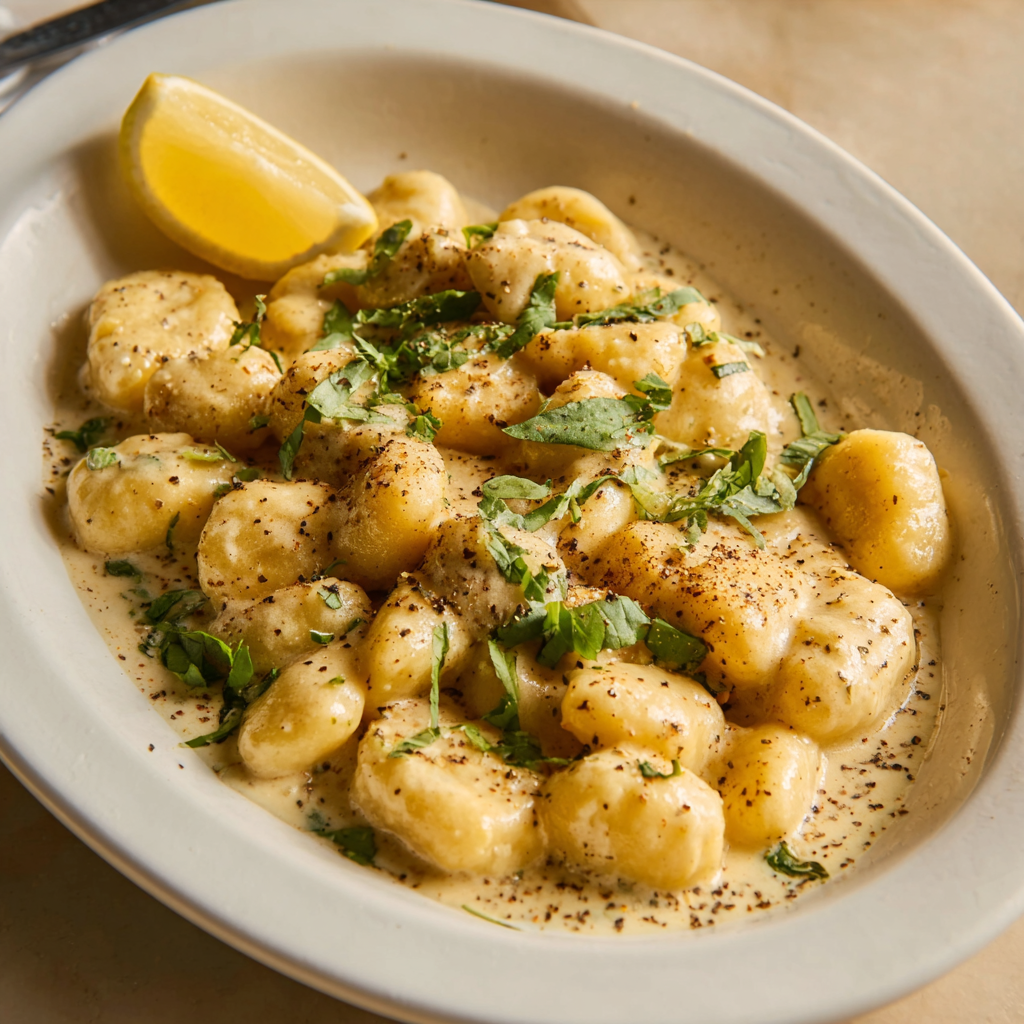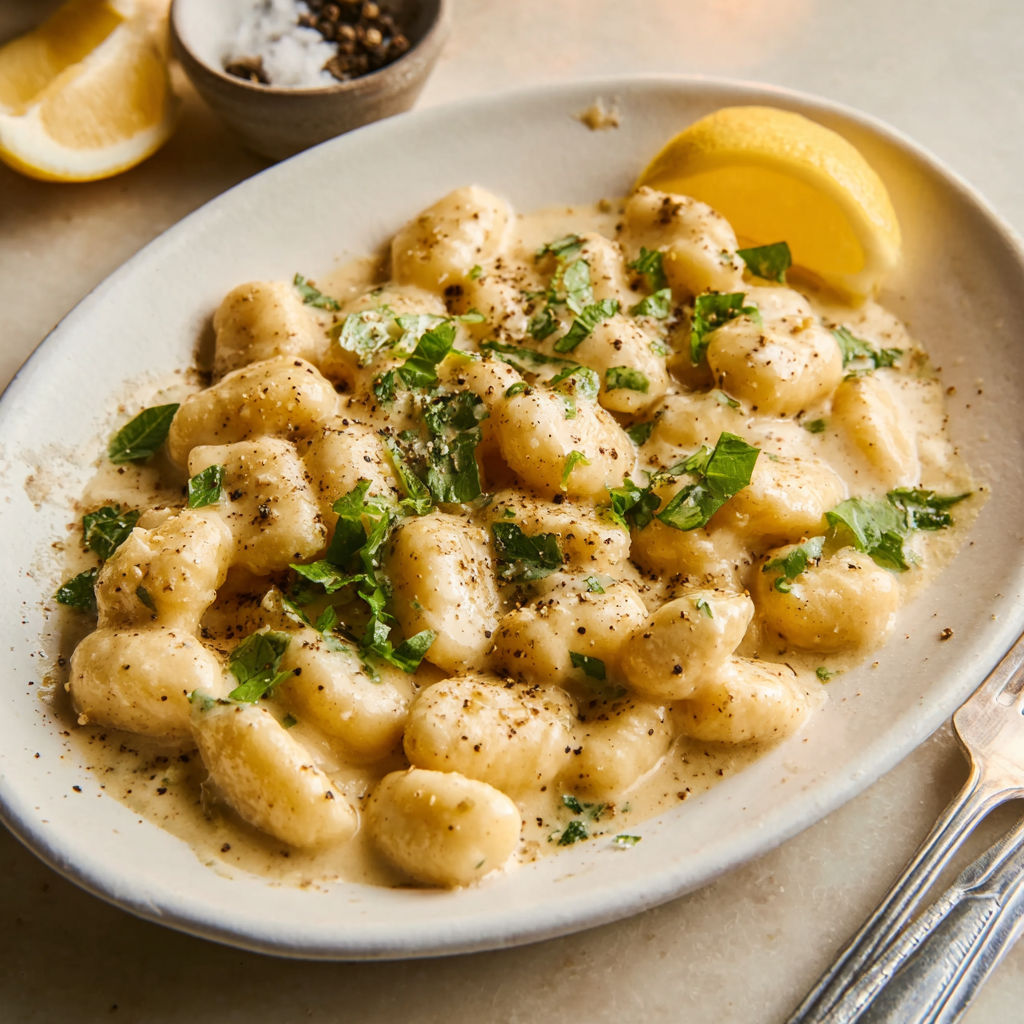1. Introduction to the Recipe
When it comes to comforting, elegant Italian dishes, easy homemade ricotta gnocchi stands out as a truly special recipe that combines delicate texture with rich flavor. Unlike traditional potato gnocchi, which requires boiling, cooling, peeling, and ricing potatoes, ricotta gnocchi are faster, lighter, and remarkably simple to prepare. These soft, pillowy dumplings are tender yet structured, making them ideal for pairing with bold sauces, light herb dressings, or classic browned butter. If you’re looking for a recipe that delivers gourmet results with minimal effort, ricotta gnocchi is the perfect solution.
For cooks who want to review traditional techniques for shaping and cooking gnocchi, this guide is incredibly helpful: https://www.seriouseats.com/how-to-make-gnocchi. If you’re exploring sauce pairings or planning a full Italian dinner, you may enjoy learning about classic Italian sauces from this reference: https://www.thekitchn.com/italian-pasta-sauce-recipes-229259. These resources expand your understanding of gnocchi preparation and offer endless possibilities for delicious experimentation.
The beauty of ricotta gnocchi lies in its simplicity. Using just ricotta, flour, cheese, eggs, and seasoning, the dough comes together in minutes. Gently rolled and cut into bite-sized pieces, the gnocchi cook quickly—often rising to the surface of the water within moments. Their mild, creamy flavor makes them adaptable to nearly any sauce, whether you prefer the nutty aroma of browned butter or the fresh acidity of tomato sauce. This recipe includes both options, giving you the flexibility to choose the finish that suits your meal or mood.
Ricotta gnocchi remain a favorite because they offer restaurant-quality texture at home without the need for special tools or extensive practice. Even novice cooks can achieve beautiful results, and once you master these steps, you’ll likely find yourself making this recipe often. This full-length article provides everything you need to perfect your easy homemade ricotta gnocchi, including advanced techniques, storage methods, dietary adaptations, FAQs, and a thoughtful final reflection on the dish’s versatility and charm.
2. Basic Recipe: Ingredients and Instructions
Print
Easy Homemade Ricotta Gnocchi Recipe
Description
This easy homemade ricotta gnocchi recipe creates soft, pillowy gnocchi with simple ingredients and two delicious sauce options.
Ingredients
Gnocchi
- 250 g / 8 oz full-fat ricotta (strictly full fat; see Note 1)
- 3/4 cup (75 g) freshly grated parmesan cheese (Note 2)
- 1 large egg (55–60 g / 2 oz)
- 1 egg yolk
- 1/4 tsp cooking salt / kosher salt
- Pinch black pepper
- 3/4 to 1 cup flour (all-purpose), plus extra for dusting (Note 3)
Browned Butter Sauce
- 4 tbsp / 60 g unsalted butter
- 1/4 tsp cooking / kosher salt (omit if using salted butter)
- Black pepper
Tomato Sauce
- 2 tbsp olive oil
- 3 garlic cloves, minced
- 1/2 onion, finely diced
- 28 oz / 800 g canned crushed tomatoes
- 1 tbsp mixed dried Italian herbs
- 1 tsp salt
- Black pepper
Garnish
- Freshly grated parmesan
- Fresh parsley, finely chopped (optional)
Instructions
- Drain the ricotta: If ricotta is wet, place it in a fine mesh strainer for 20–30 minutes to remove excess moisture.
- Make the dough: In a bowl, combine ricotta, parmesan, egg, egg yolk, salt, and pepper. Add flour gradually until a soft dough forms.
- Shape the gnocchi: Lightly flour a surface. Divide dough into 4 pieces and roll each into a long rope 3/4 inch thick. Cut into small pillows.
- Cook the gnocchi: Boil salted water. Add gnocchi and cook 1–2 minutes until they float. Remove with a slotted spoon.
- Browned butter sauce: Melt butter over medium heat until golden and nutty. Add salt and pepper. Toss gnocchi in browned butter.
- Tomato sauce: Sauté garlic and onion in olive oil. Add tomatoes, herbs, salt, and pepper. Simmer 15 minutes. Serve over gnocchi.
Notes
Dry ricotta is essential; wet ricotta leads to gummy dough.
Freshly grated parmesan melts better and improves texture.
Add flour only until dough is workable—too much makes gnocchi dense.
3. Advanced Techniques
Achieving the Perfect Dough Texture
Mastering the dough texture is crucial for easy homemade ricotta gnocchi. The ideal dough should be soft, slightly sticky, and pliable. The biggest mistake beginners make is adding too much flour, which yields heavy gnocchi. Start with the lower flour quantity and gradually add more only as needed to prevent sticking. Keep the dough cool by working quickly with your hands; warmth causes stickiness and requires extra flour. A gentle touch ensures delicate texture, so avoid kneading vigorously. Treating the dough lightly produces pillowy, tender gnocchi that hold their shape beautifully when cooked.
How to Properly Drain Ricotta for Best Results
Excess moisture is the biggest threat to good ricotta gnocchi. Draining ricotta ensures your dough forms without excessive flour. Place ricotta in a fine mesh strainer set over a bowl, cover with plastic wrap, and refrigerate for 20–60 minutes. If ricotta is extremely wet, press lightly with a spoon to encourage drainage. For very loose supermarket ricotta, wrap it in cheesecloth and gently squeeze. The drier the ricotta, the softer and more delicate the finished gnocchi will be—without becoming sticky or falling apart in boiling water.
How to Shape Gnocchi for Consistent Cooking
Achieving uniformity ensures every gnocchi cooks evenly. Roll the dough into ropes of identical thickness and cut them into evenly sized pillows. If desired, you can roll each piece on a gnocchi board or the back of a fork for classic ridges. While optional, the ridges help sauces cling more effectively. Use a bench scraper for clean cuts and a light dusting of flour to avoid sticking. Consistency in shaping not only improves cooking but enhances presentation.
Cooking Gnocchi at the Right Temperature
Cooking water should be at a gentle boil—not a violent rolling boil—which can cause delicate ricotta gnocchi to break apart. Add gnocchi in small batches so the water temperature remains stable. Once they float, wait an extra 10–20 seconds before removing them to ensure they’re fully cooked through. Using a slotted spoon instead of draining through a colander helps prevent damage. If sautéing afterward, cook them in butter over medium heat until lightly golden.
Sauce Pairing Techniques for Maximum Flavor
Ricotta gnocchi’s mild, creamy flavor makes them highly versatile. For browned butter, cook butter until nutty and use freshly cracked pepper for aroma. Add sage for a classic pairing. For tomato sauce, simmer crushed tomatoes long enough for richness, and balance acidity with a pinch of sugar if needed. You can also pair gnocchi with pesto, basil cream sauce, lemon butter, or roasted vegetable purées. Understanding sauce profiles—acidic, fatty, herb-based—helps you choose the perfect accompaniment for your meal.

4. Storage, Shelf Life, and Maintenance Tips
Refrigerating Uncooked Gnocchi
Uncooked ricotta gnocchi are delicate, so they should be refrigerated on a floured tray in a single layer. Dust lightly with flour and cover loosely with plastic wrap. They will keep for up to 24 hours before softening too much. Avoid stacking, which causes deformation. When ready to cook, boil directly from the fridge—do not let them sit at room temperature where they may become sticky.
Freezing Gnocchi for Long-Term Storage
To freeze, place gnocchi in a single layer on a baking sheet and freeze until firm. Transfer to freezer bags and store for up to 2 months. Cook directly from frozen without thawing, adding 30–60 seconds to the boiling time. This method preserves texture and prevents them from sticking together. Label the bag so you can track freshness easily.
Storing Cooked Gnocchi Safely
Cooked gnocchi can be stored in the refrigerator for 2 days. Toss lightly with olive oil to prevent sticking. Store sauces separately to maintain texture. When reheating, gently warm in a skillet with butter or sauce. Avoid microwaving, which toughens the gnocchi and causes uneven heating. For best texture, consume freshly cooked whenever possible.
Keeping Sauces Fresh and Flavorful
Browned butter sauce can be refrigerated for 3–4 days and reheated gently over low heat. Tomato sauce lasts 4–5 days and tastes better as flavors meld. Freeze extra sauce in small containers for easy portioning. When reheating tomato sauce, add a splash of water to restore consistency. For browned butter, reheat minimally to preserve its nutty aroma.
Reviving Leftover Gnocchi
Leftover gnocchi may firm up after refrigeration. To revive them, sauté gently in butter or olive oil until warmed through and lightly crisped. This gives them a slightly chewy, golden exterior that many find even more delicious than freshly boiled gnocchi. Avoid boiling cooked gnocchi again, which will make them mushy.

5. Dietary Adaptations and Substitutions
Gluten-Free Adaptations
To make easy homemade ricotta gnocchi gluten-free, substitute all-purpose flour with a 1:1 gluten-free baking blend that contains xanthan gum. Start with small amounts and add gradually. Ricotta-based gnocchi adapt well to gluten-free flour because the dough structure doesn’t rely heavily on gluten formation. Ensure sauces use gluten-free ingredients—most tomato-based and butter sauces are naturally safe.
Low-Carb or Keto-Friendly Version
Traditional gnocchi are high in carbohydrates due to the flour. For a low-carb version, reduce flour to the minimum needed for shaping and use almond flour or fine coconut flour as partial substitutes. Note that texture will vary, becoming softer and slightly more delicate. Serve with butter-based or creamy sauces rather than tomato sauce for best results.
Dairy-Free Adaptation
Ricotta and parmesan are central to the recipe, but dairy-free alternatives make it possible to adapt. Use almond-based or coconut-based ricotta substitutes and a dairy-free parmesan-style cheese. Check ingredient labels for consistency; some dairy-free ricotta brands contain more moisture and require longer draining. Replace butter with vegan butter or olive oil for sauces.
Low-Sodium Version
Reduce salt in both gnocchi and sauces. Parmesan contains natural saltiness, so cutting added salt still results in balanced flavor. Use no-salt canned tomatoes and choose unsalted butter for the browned butter sauce. Fresh herbs like basil, parsley, and thyme enhance flavor without relying on sodium.
Egg-Free Adaptation
While eggs help bind the dough, you can try using 2–3 tablespoons of aquafaba (chickpea water) as a substitute. Add gradually and monitor texture. The dough will be more delicate but still workable with gentle handling. Pair with a thicker sauce to help hold the gnocchi together.

6. FAQs About the Recipe
Why Are My Gnocchi Too Sticky?
Sticky dough usually means ricotta contains too much moisture or too little flour was used. Drain ricotta thoroughly before mixing. Add flour gradually until dough is soft but workable. Dusting the work surface and hands lightly with flour also helps prevent sticking. Avoid overmixing, which warms the dough and increases stickiness.
Why Are My Gnocchi Dense or Hard?
Too much flour creates dense gnocchi. Always start with less and add only what’s necessary. Overkneading also toughens the dough by developing gluten. Handle the dough gently and minimally. Ensure ricotta is full-fat; low-fat ricotta contains more moisture and requires more flour to compensate.
How Do I Prevent Gnocchi from Falling Apart in Water?
If gnocchi fall apart, the dough likely contains too little flour or too much moisture. Draining ricotta well is key. Remember to boil gently, not violently, since aggressive bubbling can break delicate gnocchi. Adding a touch more flour helps stabilize the dough.
Can I Make the Gnocchi Dough Ahead of Time?
You can prepare dough up to 12–24 hours ahead, but store it tightly wrapped in the refrigerator. Roll and cut shortly before cooking. Dough stored too long may release moisture, requiring additional flour when shaping. Alternatively, shape the gnocchi and refrigerate or freeze.
What Sauces Pair Best with Ricotta Gnocchi?
Ricotta gnocchi pair beautifully with browned butter and sage, marinara, basil pesto, gorgonzola cream sauce, roasted vegetable purées, or even simple olive oil with garlic. Their mild flavor makes them a versatile base for nearly any sauce. Consider the season when choosing sauces—light in summer, richer in winter.

7. Conclusion & Final Thoughts
Easy homemade ricotta gnocchi is a delightful recipe that offers simplicity, elegance, and incredible versatility. Whether you’re cooking for a quiet weeknight dinner or preparing a special meal for guests, ricotta gnocchi bring softness, comfort, and a touch of Italian tradition to your table. Unlike potato gnocchi, which can be time-intensive and inconsistent, ricotta gnocchi deliver dependable results with minimal skill required. They are quick to prepare, easy to shape, and fast to cook, making them perfect for both busy cooks and passionate food lovers alike.
The sauces included in this recipe—brown butter and tomato—are timeless yet distinct options that show how well ricotta gnocchi pair with both rich and bright flavors. Browned butter highlights their creamy texture, while tomato sauce adds tang and depth. Beyond these, countless other sauce combinations allow you to personalize the dish, making it one of the most adaptable recipes in Italian cooking.
What makes this dish truly special is how it transforms a handful of simple ingredients into something memorable and satisfying. The techniques covered in this guide help ensure your gnocchi are consistently tender and light, while the storage tips and dietary adaptations give flexibility for different preferences and lifestyles. Whether you’re new to making gnocchi or refining your technique, this recipe empowers you to create homemade pasta that tastes restaurant-worthy.
Once you master the steps, easy homemade ricotta gnocchi becomes a reliable staple—a dish you can turn to anytime you want something comforting, elegant, and undeniably delicious.
